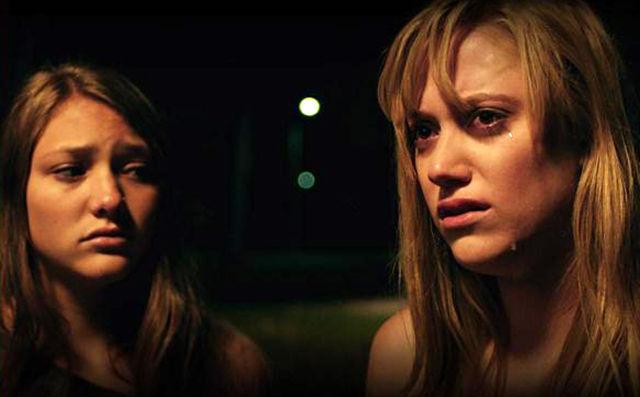We only see once in the entirety of “It Follows” what happens when the “it” catches up to the victim it has been plaguing. The film is more interested in establishing a sense of lurking terror, a malaise of metastasizing anxiety that permeates the movie’s scenes and infects its characters as well as the audience.
The film follows our protagonist Jay (Maika Monroe) as she copes with the “it” following her. She inherits a curse by having sex with a guy she has been dating, and the affliction causes a mysterious being to stalk her. The being in question can take any form; it cannot speak, and its sole form of travel is walking at a gradual, unstopping pace.
No matter how far away Jay runs, she will permanently be followed, unless she passes the curse on to someone else.
The opening scene of “It Follows” tracks the demise of the person haunted immediately before Jay. A young woman emerges from her home, half-dressed and in heels that throw staccato noises against the sidewalk. She frantically paces about before retrieving her purse and driving away.
We next see her on the beach, speaking goodbyes into her cell phone as she becomes increasingly distressed. This scene cuts away to reveal her corpse grossly distorted. This event, a precedent for the rest of the movie, establishes the genuine threat our characters encounter in their affiliation with the creature.
“It Follows” takes place in an unspecified time. The main characters watch television on decrepit old sets and traipse through dreamy visions without cell phones. Yet, certain other things hint at modernity, such as a clam-shell e-reader one of the protagonist’s friends totes around so she can orate thematically appropriate poetry when it comes time.
The environment of the film instills a poignant sense of nostalgia, adequately setting the stage for the characters’ punitive confrontation with adulthood.
The ambience contributes to the dreamlike feel of the movie. This dream world is further extended by the grabbing score and the beauty of David Robert Mitchell’s direction. Mitchell ensures that the being’s presence is always felt; half the time it exists in the background, its movements slow but unyielding. It is perhaps more harrowing when the camera cuts away from it. Where is it? When will it be here?
Though the cast is filled with relative unknowns, they all prove to be up to the task at hand. They aptly embody characters that are equal parts terror-driven angst and thoughtfulness.
Monroe is especially excellent as Jay, imbuing the character with desperation and quiet strength. She is scared and feels hopeless, but this does not define her. She longs for childhood, a notion that “It Follows” focuses on quite intently.
It is somewhat easy to draw parallels and imagine metaphors regarding the curse and its means of distribution. One could view Jay’s procurement of her unique disorder as a representation of how women are so frequently marked and plagued by their expressions of sexuality, a fact that follows them no matter what they do to remove themselves from it.
A more layman’s example of this is present in season two of “Buffy the Vampire Slayer,” in which Buffy’s intimate encounter with Angel causes her boyfriend to literally transform into a demon. However, “It Follows” is somewhat beyond sexual allegory; its imagined, ever-present threat is so vaguely horrifying that it at times fails to embody much more than a deep-seated apprehension that we cannot fully grasp.
For a movie to be truly unsettling, its creators must consider what its audience will find unsettling. “It Follows” is as much a coming-of-age story as it is an artful horror film. In preying on the phobia of losing adolescence, it appeals to a universal fear that is as inescapable as the titular “it.” It follows, whether we like it or not.








